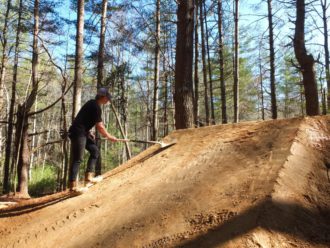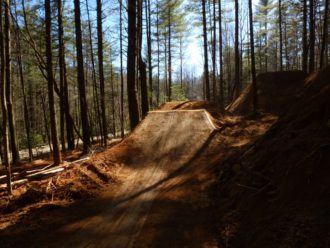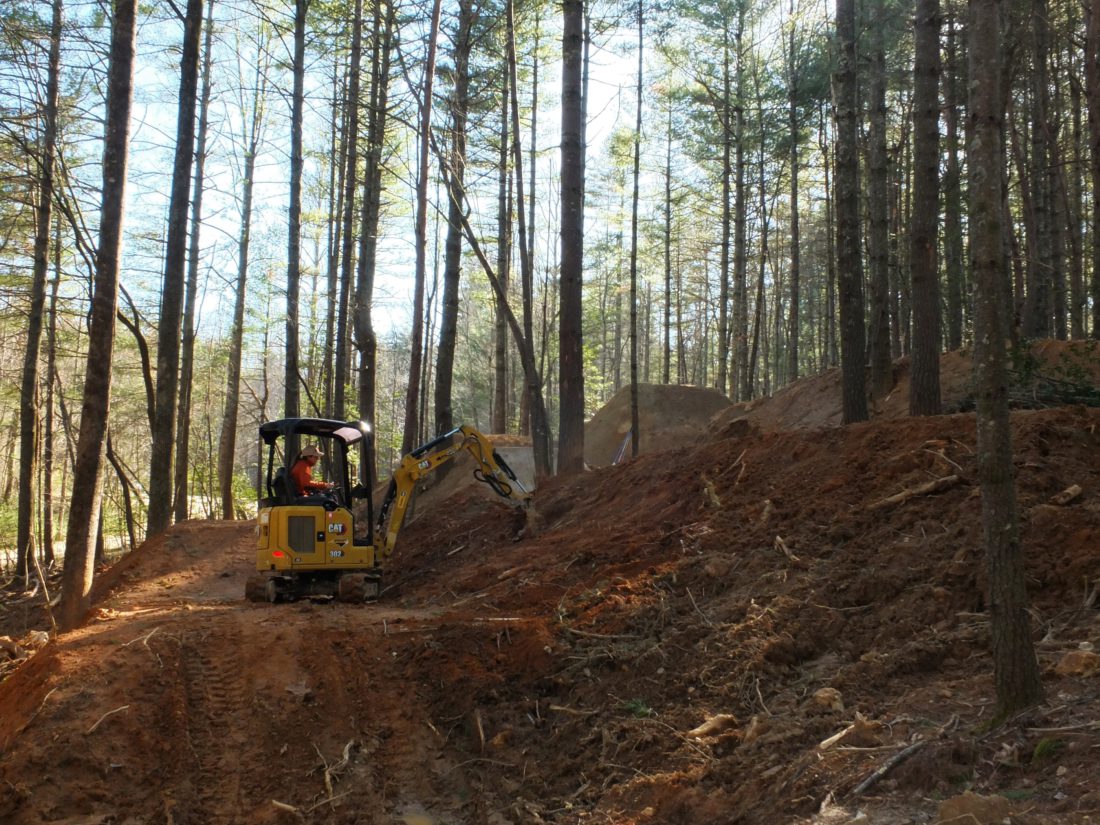By Lauren Ketwitz, originally published by UNC Media Hub
An untrained eye might gaze up at a North Carolina mountain side and see trees, a few rocks, and roots covering the ground. But for a trail builder like Hayden Gary, the earth that lies before him is teeming with untapped potential.
Gary is a downhill mountain bike racer and trail builder at Ride Kanuga, a bike park in Hendersonville. When he looks out into the woods, a trail — with all its twists, turns and thrills — is already being pieced together inside his head.
“I try to pinpoint key spots where the terrain is perfect for certain features like a jump or a drop,” Gary said. “Once those have been established, I just figure out the best way to connect the dots.”
Trail building is a science that requires precise measurements and calculations. However, it’s also a complex art, practiced by around a dozen teams of specialized builders in the state.
Western North Carolina is a mountain biking hub on the East Coast. The state has some of the best mountain biking to be found, with gravel roads that wind along lazy streams, or trails that climb up steep mountainsides; trails that cross 5,000-foot mountain peaks or singletrack that traverses long, narrow ridgelines: all are here within the boundaries of the Old North State.
And demand for new trails is high. Since the beginning of the pandemic, mountain biking has skyrocketed in popularity nationwide. As a result, the demand for new trails and trail management also increased. In 2020, more than 3,000 miles of trail were designed, and over 1,500 miles of trail built, by members of the Professional Trail Builders Association alone.
Although they can come all in different shapes, styles and sizes, mountain bike trails all start the same: a plot of land and a team of trail builders with a vision.
Carving out trails can be difficult if a builder doesn’t know how it should feel on a bike. That’s where having experience as a mountain bike rider can come in handy. Not surprisingly, many of the people in the trail building industry in North Carolina are competitive riders as well.

“I always want my builders to be riders,” said Callie Horwath, the manager of, and a trail builder, at Ride Kanuga. “Riders know how a trail is supposed to flow and what makes them fun just from experience on their bike.”
Each section of trail acts as a puzzle piece. To complete the puzzle, every piece has to fit together perfectly; if one piece doesn’t sit right, then the puzzle isn’t finished.
Peter Mills has been solving these puzzles for years. He is the founder of Elevated Trail Design, a company based in Asheville. After working in the industry for over a decade, Mills is no stranger to the assumptions made about his line of work.
“People think we’re just racing around on our bikes and hi-fiving each other, but we’re out there working when it’s pouring rain and the wind is blowing sideways,” Mills said.
Trail building isn’t for the faint of heart. Long days and tricky weather conditions paired with big machinery don’t always pair well.
North Carolina gets an average of 48 inches of rain every year, which is 10 inches higher than the national average. Unexpected downpours can turn a job site into a mudslide overnight. Sometimes, builders are also battling with their equipment.
“I’ve definitely had an excavator sink deep into some mud before,” Gary said. “You deal with a lot of potentially dangerous situations using those machines.”
Gary has built multiple race tracks for the Downhill Southeast bike race series, one of the largest regional race series in the United States. He’s also built and maintained countless sections of trail at Ride Kanuga.
“Being an experienced racer allows me to anticipate how speed will carry through a line I’m building,” he said. “I have a solid understanding of how my bike will interact with the trail before it’s even ridden.”
Gary competes domestically at the pro level. If he didn’t build trails, he suspects he wouldn’t be nearly as good of a rider, and vice versa.

“You can learn so much about trail building just by getting comfortable on a bike- and finding what feels good,” he said.
On top of finding what feels good, trail builders also follow regulations to ensure safety and sustainability. The U.S. Forest Service has a trail construction and maintenance notebook packed with information and how-tos. In addition, the National Park Service published a handbook that details how to build and manage different types of trails.
Although most bike parks aren’t located in a national park, it is important that trail builders are well-read in the trail design and management laws. Each trail must be approved by the county they’re in to avoid legal trouble, or an unsustainable trail.
As they keep all of these things in mind, trail builders can spend hours building out a section of trail, only to rethink it and begin the process all over. According to Mills, trail builders have to be thick-skinned when it comes to criticism: every rider is a critic.
Trail building is like composing music to Ed Sutton, the president of Trail Dynamics, a trail-building company in Pisgah Forest. Everyone plays their own instrument, but there isn’t a song until they all play together. This musical flow is also present in the trail itself; sections are tuned and tweaked until they blend seamlessly.
Like a symphony, building a trail involves countless moving parts that, on their own, are relatively simple. But when it comes time to perform, the entire orchestra — a finished trail — plays together.
Many people have only experienced mountain biking through the lens of a GoPro camera mounted on a downhill racer’s helmet. The trails they compete on are extremely technical and tower over any other kind of trail in regards to difficulty.
These trails are intended to push riders to their limits. On any given one, a rider can expect to find huge jumps spanning tens of feet, staggering rock drops and craggy rock gardens that test a rider’s strength, balance and intuition on their bike.

Other trails have a much less aggressive stance to gear them toward a wider variety of riders.
“The average bike trail has a steepness grade of about 5%,” said Sutton. “Going above that makes the trail too difficult for beginner and intermediate riders to enjoy.”
Whether the trail shoots straight down the mountain or meanders back and forth, every good trail incorporates certain features to create a satisfying ride.
Rollers are small mounds of dirt that are packed into place on a trail, usually with more than one in a row. Rollers allow riders to pump over the mounds, which increases their speed and produces a “rollercoaster” effect.
A berm is a turn that is built up out of the earth, so that the rider becomes more parallel to the ground and is designed specifically to divert the rider’s speed in the direction they exit.
When building on and around these features, trail builders have to keep drainage in mind. If there’s one enemy of a trail, it’s rain.
“I always tell people the first rule of trail building is to think like a raindrop,” said Horwath. “If rain hits the trail, where is it going to end up? No one wants to ride their bike through a swimming pool.”
Unwanted swimming pools aren’t the only issue if runoff isn’t dealt with properly.
“Water will run straight down a trail and create deep channels and gulleys,” said Seth Alvo, a mountain biker from Asheville. “Periodically directing water away from a trail as it moves down the mountain keeps it sustainable.”
Alvo shares his enthusiasm for mountain bike riding and trail building on his YouTube channel, Berm Peak. Formerly known as Seth’s Bike Hacks, the channel boasts a following of almost two-and-a-half million users and is recognized as one of the biggest mountain biking channels in the world.
It is also important to invest in the “funness” of a trail, according to Alvo. Not only does this bring more people out to the trail, but it also lowers the chance of a rider deciding to blaze their own path through the woods. If enough riders follow the unofficial route, it can make the entire area surrounding the original trail unsustainable.
“As a mountain biker with some influence, I try to dissuade people from doing that because it completely undermines what we [builders] are trying to do,” said Alvo.
Trail builders are a relatively small population in North Carolina – There’s plenty of ground to be covered by the dozen or so teams in the state. Having such a small ring of builders and designers fosters more close-knit relationships and willingness to inspire one another.
The construction of a trail represents a safe and fun outlet for the public to reconnect with nature, says Mills. In addition, every trail built is a new piece of land that is conserved and maintained. As long as the greenspace is used by the public, there is little to no chance it will ever be developed.
Until recently, many areas in WNC were trail dead zones. On the Eastern Band of Cherokee Indians’ Qualla Boundary, there were no biking trails for over an hour’s drive until the tribe hired Sutton to build them a trail system.
While working with the tribe, Sutton bonded with a member who struggled going in and out of rehab before he was introduced to mountain biking. Several years down the road, he and Sutton remain fast friends and continue to ride together.
“The work I do has the potential to bring happiness and health to hundreds of new people,” Sutton said. “That’s what gets me out of bed in the mornings.”
UNC Media Hub is a collection of students from the various concentrations in the Hussman School of Journalism and Media working together to create integrated and free multimedia packages covering stories from around North Carolina.




Before you comment
The comments section is here to provide a platform for civil dialogue on the issues we face together as a local community. Xpress is committed to offering this platform for all voices, but when the tone of the discussion gets nasty or strays off topic, we believe many people choose not to participate. Xpress editors are determined to moderate comments to ensure a constructive interchange is maintained. All comments judged not to be in keeping with the spirit of civil discourse will be removed and repeat violators will be banned. See here for our terms of service. Thank you for being part of this effort to promote respectful discussion.